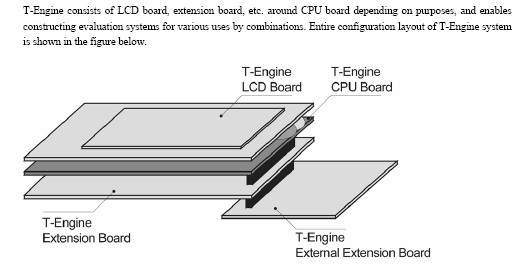TRON
TRON was designed by Ken Sakamura of the University of Tokyo as a universal operating system standard that would run in real time, like the in-flight systems used on an airline. TRON was never an OS; rather, it was a set of standards, like POSIX, with a strict hierarchy. At the top was the macro-TRON (MTRON), that would act as the set of standards for universal interface across computer systems. Then came CTRON, used in the largest computers, such as supercomputers, mainframes, and telephone switching systems. Then came BTRON, a standard business system architecture, and ITRON, the industrial microcontroller OS. MTRON was evidently never more than an ideal, and no implementations exist. CTRON acquired NTT as a backer, but the architecture was confined to a line of telephone switches.1 A variant of ITRON, micro-ITRON, has become a fairly common standard for niche applications, such as navigation systems.
Ken Sakamura, who by all accounts is a lovable and politically astute man, contrived to start the T-Engine Forum. I was struck by the way the literature appeared to have been written by Borat:
This is Sakamura's second (?) career as a tech guru. The article I linked to strikes me as something of a joke: identify a large number of objects that have some abstract feature in common, such as the potential to store data; then create a "standard" that consists of terminology so abstract it can embrace them; and announce your technology is "ubiquitous." Fortify the article with references to vapid platitudes and toss in a nightmarish, but influential, guru from the past—like Le Corbusier or Buckminster Fuller. Capitalize on the lesser-known tendency of Japanese sarariman to join professional associations just because it's possible, and one can drop any number of impressive names.In an emergency, Toyota’s Prius hybrid automobile can supply the Toyota home with electricity. The house gives new meaning to Le Corbusier’s famous exclamation that a dwelling is "a machine for living."
("T-Engine [...] Ready for Prime Time" [PDF] 2005)
I was immensely surprised to learn that TRON, a project to create a single comprehensive OS for the whole of the incipient Japanese IT industry in the '80's, which was launched from the nation's most prestigious university, and briefly embraced by NTT, never went anywhere. It was never much more than a Zen joke (like this T-Engine hardware spec; see figure below).

By the 1980's, the standard business model in Japan included assimilation of existing technical standards, like DOS/V, and excelling within that field. The market was sufficiently segmented that, unless unavoidable, Japanese firms avoiding taking a stand of their own on an industrial standard. Rather like the brilliant politician, whose career consists of avoiding difficult positions and anticipating popular ones, the Japanese technology firms seemed to use standards like decals. Executives were alarmed when they discovered embracing a new technology meant slamming the door on another. Because of this, TRON withered on the vine. It was distinguished by the amazing abilities of its godfather, Prof. Sakamura, to look like a decisive guru.
1 My link to the CTRON page is basically Ken Sakamura's plug for the concept. The page is now almost 10 years old, which is about the point when TRON largely vanished as a developmental objective. He mentions several firms, such as Tandem, developing a fault-tolerant devices and switching systems based on this standard, then sums up that it "is a standard" in Japan. Those firms were contractors for NTT. A few enthusiasts, unfamiliar with IT terminology and claims, or prone to hyperbole, have gone so far as to insist it's "the most popular operating system in the world"(ITRON is not an OS). Almost none of the information in the linked article is true or, for that matter, logically coherent enough to be true OR false.
Keiretsu: The keiretsu (business group) model is distinct from the business group found everywhere else in the world in that it has the external linkage (crossholding of shares) and standard convoy structure, with a trading house, commercial bank, and investment bank at its core. At its culmination of development, the Japanese economy was dominated by six keiretsu, each with its own commercial bank. A seventh bank, the Industrial Bank of Japan, was the battle cruiser in the financial convoy system. The entire system was restructured out of existence in the late '90's, as the seven banks were merged into three and the non-financial firms developed a somewhat more conventional relationship.
Labels: operating systems, technology



0 Comments:
Post a Comment
<< Home